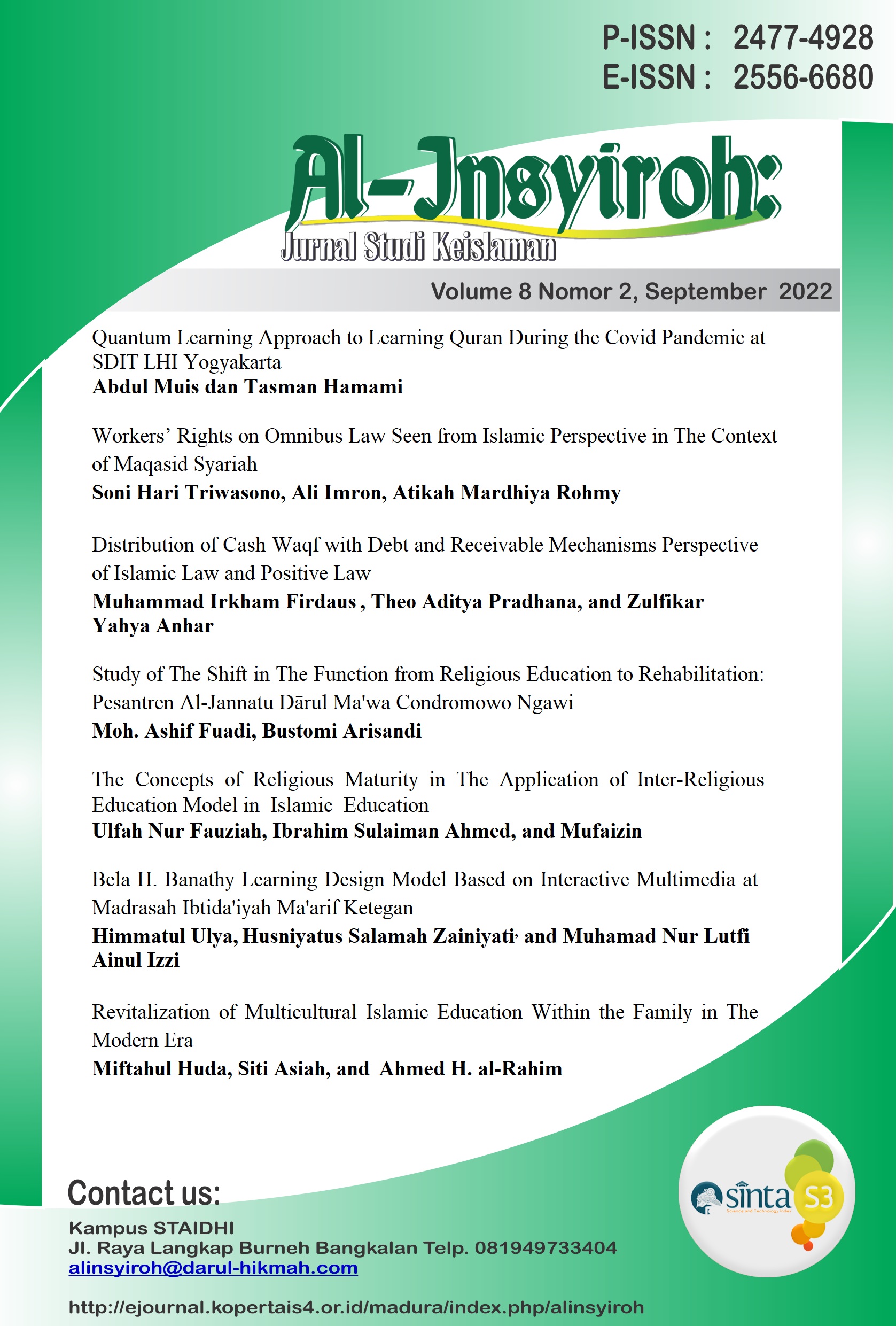Distribution of Cash Waqf with Debt and Receivable Mechanisms Perspective of Islamic Law and Positive Law
DOI:
https://doi.org/10.35309/alinsyiroh.v8i2.5682Keywords:
Distribution, Cash Waqf, Accounts Payable, Islamic LawAbstract
Cash waqf has great potential as a source of productive waqf funds that aim to build the people's economy and improve the welfare of the community. Productive waqf is the waqf property used in production activities and the results are distributed according to the purpose of the waqf. Many productive waqf designs have been developed by several parties engaged in the Islamic economic sector, such as the distribution of cash waqf funds for the empowerment of small and medium enterprises (SME). As has been done by the Global Action Agency for Fast Responses in Madiun, in which the distribution of waqf funds is channeled to small and medium-sized enterprises owned by the community using a debit and credit mechanism. There are pros and cons to the design of productive waqf like this because according to some opinions, waqf funds can only be produced for the social interests of the people, not for personal use, besides that according to waqf regulations in force in Indonesia, waqf assets may not be sold, given away, used as collateral, and may not be used as collateral. transferred in the form of transfer of other things. Departing from the various problems that need to be reviewed and analyzed in-depth, the researchers used a qualitative descriptive method by describing the actual state of the phenomenon of the object under study and then comparing it with the existing theory. The first stage is to collect data regarding the management and distribution practices of Cash Waqf funds at the Global Action Agency for Aksi Cepat Tanggap Madiun. The second stage is managing the data that has been obtained, then the last stage, the data obtained is tested and analyzed according to Islamic law and waqf regulations in Indonesia, and then finds the results of the research. With the source of the data obtained from the ACT Institution and the party receiving the funds used for the source and SME. The purpose of this study was to find out the practice of managing and distributing cash waqf funds at the Global Aksi Cepat Tanggap Madiun Institute and to determine their compliance with Islamic law and waqf regulations that apply in Indonesia.References
وهبة الزهيلي. Ùقه الإسلامى وأدلته. دمشق: دار الÙكر, 1985.
Astuti, Daharmi, Boy Syamsul Bakhri, and Masrayanti Masrayanti. “Pemetaan Potensi Wakaf Produktif Di Kota Pekanbaru.†Al-Hikmah: Jurnal Agama Dan Ilmu Pengetahuan 18, no. 2 (2021): 104–9. https://doi.org/10.25299/al-hikmah:jaip.2021.vol18(2).5344.
Bank Indonesia. WAKAF: Pengaturan Dan Tata Kelola Yang Efektif,. Isbn. Jakarta: Departemen Ekonomi dan Keuangan Syariah, 2016.
Choiriyah. “Wakaf Produktif Dan Tata Cara Pengelolaannya.†Islamic Banking 2, no. 2 (2017). https://ejournal.stebisigm.ac.id/index.php/isbank/article/view/29/21.
Dipayanti, Kris, and Nufzatutsaniah. “Pengelolaan Wakaf Produktif Terhadap Peningkatan Perekonomian Masyarakat Tangerang Selatan.†Jurnal Ilmiah Manajemen Forkamma 4, no. 1 (2020): 14–23. http://www.openjournal.unpam.ac.id/index.php/FRKM/article/view/6928/5226.
Furqon, Ahmad. “Model-Model Pembiayaan Wakaf Tanah.†Economica: Jurnal Ekonomi Islam V (2014): 1–20. 10.21580/economica.2014.5.1.760.
Islamiyati, Islamiyati, Nur Adim, and Rizki Fitria Sari. “Hambatan Penyelesaian Sengketa Tanah Wakaf Pada Proyek Pembangunan Jalan Tol Dan Solusinya (Studi Kasus Di Kabupaten Jombang).†Edited by G. Balint, B. Antala, C. Carty, J-M. A. Mabieme, I. B. Amar, and A. Kaplanova. Diponegoro Private Law Review 7, no. 2 (December 10, 2020): 343–54. https://doi.org/10.2/JQUERY.MIN.JS.
Jamal, Mulyono, Jarman Arroisi, and Nia Puji. “Implementasi Pendistribusian Wakaf Tunai Sebagai Penunjang Usaha Kecil Menengah Di Badan Wakaf Uang & Badan Wakaf Tunai MUI Yogyakarta Mulyono.†Ulul Albab: Jurnal Studi Dan Penelitian Hukum Islam 3, no. 1 (2019): 49–66.
Khoerudin, Abdul Nasir. “Tujuan Dan Fungsi Wakaf Menurut Para Ulama Dan Undang-Undang Di Indonesia.†TAZKIYA Jurnal Keislaman, Kemasyarakatan & Kebudayaan 19, no. 2 (2018): 1–10.
Majelis Ulama Indonesia. “Keputusan Fatwa Majelis Ulama Indonesia Tentang Wakaf Uang,†2002.
Moleong, Lexy. Metodologi Penelitian Kualitatif. Bandung, 2005. PT. Remaja Rosdakarya.
Mufaizin, M. Nasionalisme dalam Perspektif Alquran dan Hadits. Al-Insyiroh, 5(1), 40-56.
Nurhayati, Sri. Akuntansi Syariah Di Indonesia. Jakarta: Salemba Empat, 2009. https://books.google.co.id/books?hl=en&lr=&id=IKD2K3GEkuUC&oi=fnd&pg=PA1&dq=Sri+Nurhayati,+Akuntansi+Syariah+di+Indonesia,+(Jakarta:+Salemba+empat,+2009)p&ots=xWULvoPxDY&sig=s7fi2R2jYgYZOhbOEcgyJFTMaI0&redir_esc=y#v=onepage&q&f=false.
Putra, M. K. B. (2015). Eksistensi Sistem Pesantren Salafiyah dalam Menghadapi Era Modern. Al-Insyiroh: Jurnal Studi Keislaman, 1(1), 87-104.
Qahaf, Munzir. Manajemen Wakaf Produktif. Jakarta: Pustaka Kautsar Grup, 2005.
Qosim, Nanang. “Wakaf Uang Dalam Perspektif Hukum Islam.†Jurnal Asy-Syari’ah 4, no. 1 (2018): 51–62.
Ridwan, Murtadho. “Wakaf Dan Pembangunan Ekonomi.†ZISWAF : Jurnal Zakat Dan Wakaf 4, no. 1 (2018): 105. https://doi.org/10.21043/ziswaf.v4i1.3034.
Rusydiana, Aam S, and Abrista Devi. “Analisis Pengelolaan Dana Wakaf Uang Di Indonesia : Pendekatan Metode Analytic Network Process ( Anp ).†Al-Awqaf: Jurnal Wakaf Dan Ekonomi Islam 10, no. 1 (2020).
Shulthoni, Muhammad, and Norma Md Saad. “Waqf Fundraising Management: A Conceptual Comparison between Traditional and Modern Methods Inthe Waqf Institutions.†Indonesian Journal of Islam and Muslim Societies 8, no. 1 (2018): 57–86. https://doi.org/10.18326/ijims.v8i1.57-86.
Siregar, Liesma Maywarni, and Puguh Setiawan. “Wakaf Sebagai Ibadah Sosial Berkelanjutan.†Tajdid: Majalah Ilmu Pengetahuan Dan Pemikirab Keagamaan 23, no. 2 (2020).
Sugiyono. Metode Penelitian Kuantitatif Dan Kualitatif. Bandung: Alfabeta, 2009.
Sukma, Febri Annisa, Refki Kurniadi Akbar, Nuri Nur Azizah, and Giri Putri Juliani. “Konsep Dan Implementasi Akad Qardhul Hasan Pada Perbankan Syariah Dan Manfaatnya.†Amwaluna: Jurnal Ekonomi Dan Keuangan Syariah 3, no. 2 (2019). https://doi.org/10.29313/amwaluna.v3i2.4296.
Sup, Devid Frastiawan amir. “Wakaf Kontemporer Di Indonesia Dalam Perspektif Hukum Dan Fatwa.†Jurnal Hukum Ekonomi Syariah 4, no. 2 (2021): 237–56. http://www.jurnalnasional.ump.ac.id/index.php/JHES/article/view/11093%0Ahttp://www.jurnalnasional.ump.ac.id/index.php/JHES/article/download/11093/4413.
Syafi’i, Muhammad. Arah Manajemen Wakaf (Traditional-Modern). Jember: CV. Pustaka Abadi, 2017.
Ulum, B. (2019). Hukum yang Hidup dalam Masyarakat untuk Mengkualifikasikan Lesbian, Gay, Biseks, dan Transgender sebagai Tindak Pidana. Al-Insyiroh: Jurnal Studi Keislaman, 5(1), 106-117.
“Undang-Undang Republik Indonesia Nomor 41 Tahun 2004 Tentang Wakaf,†2004. http://dx.doi.org/10.1016/j.buildenv.2015.02.015.
Usman, Nurodin. “Varian Mauquf Alaih Am Sebagai Alternatif Dalam Pengembangan Wakaf Produktif.†Al-Ahkam Jurnal Ilmu Syari’ah Dan Hukum 2, no. 1 (2017). https://doi.org/10.22515/alahkam.v2i1.757.
Yunus, Muhammad, and Syafrudin Syam Pagar. “PEMINDAHAN TANAH WAKAF MENURUT UNDANG-UNDANG NO. 41 TAHUN 2004 TENTANG WAKAF (Studi Kasus Di Kota Medan).†DirectorAT-TAFAHUM: Journal of Islamic Law 2, no. 1 (2018): 210–30. https://www.uam.es/gruposinv/meva/publicaciones jesus/capitulos_espanyol_jesus/2005_motivacion para el aprendizaje Perspectiva alumnos.pdf%0Ahttps://www.researchgate.net/profile/Juan_Aparicio7/publication/253571379_Los_estudios_sobre_el_cambio_conceptual_.
Downloads
Published
How to Cite
Issue
Section
License
Copyright (c) 2022 Al-Insyiroh: Jurnal Studi Keislaman

This work is licensed under a Creative Commons Attribution-ShareAlike 4.0 International License.

This work is licensed under a Creative Commons Attribution-ShareAlike 4.0 International License.









